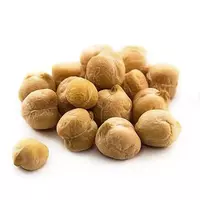Chick-pea

Experienced culinary experts, and just pea lovers, know that chickpeas are called small brown-green beans, which in appearance very much resemble the head of an owl or lamb. Compared to regular peas, Chickpeas features a larger size and rough surface.
Interestingly, this product has quite a few other names, among which are known such as Turkish or lamb peas, shish peas, nahat or bubble. The calorie content of chickpeas is quite high, so we can safely say that this is a rather nutritious product, in connection with which a very small portion of this bean dish is needed to feel full.
People know not only the numerous beneficial properties of chickpeas, but also the high gastronomic qualities of this product, therefore, there are a considerable number of dishes based on it. It is customary to cook, fry or preserve beans, while they can be served as a side dish to stew.
Chickpeas have a pleasant nutty taste. Boiled and crushed to consistency, beans are a hearty snack that is common in Israel and is called hummus. And in Arab cuisine, this mash is used to prepare a national dish of falafel, frying chickpeas until crisp.
Chickpea flour is a mandatory attribute of Indian cuisine, but Italian culinary experts also adopted it: farinata tortillas are made from it. In addition, in the Philippines, it is customary to preserve chickpeas in syrup - in this form it acts as a dessert of halo-halo or Philippine ice cream. Such love for this product is probably due to its beneficial properties, which are justified by the composition of chickpeas.
Composition of chickpeas
First of all, I would like to note that chickpeas include such an important element as manganese, which is an enzyme necessary for the production of energy and antioxidant defense of the body. It is known that when only one cup of chickpeas is consumed, a person replenishes the daily norm of this substance by 8
4. 5 percent.
In addition, there are other equally important minerals and vitamins in the composition of chickpeas: calcium, selenium, copper, zinc, iron, iodine, sodium, vitamin A, V1, PP, beta-carotene and many other elements necessary for human health.
The benefits of chickpeas
The benefits of chickpeas are especially clearly revealed in a prophetic form - that is why many experts recommend using it as a natural cleansing agent. In addition, chickpea sprouts are very useful for children and the elderly, as they are a natural product that has a preventive effect in the fight against colds.
Like most legumes, chickpeas are an indispensable source of special fibers that can lower blood cholesterol levels. According to numerous studies, the benefit of chickpeas lies in the ability to reduce the likely risk of strokes, heart attacks and other cardiovascular diseases.
chickpeas 309 kCal
Energy value of chickpeas (Ratio of proteins, fats, carbohydrates - ju):
Proteins: 20.1 g (~ 80 kCal)
Fats: 4.32g (~ 39kCal)
Carbohydrates: 46.16 (~ 185 kCal)
Energy ratio (bj | y): 26% | 13% | 60%
 Español
Español Français
Français Português
Português Русский
Русский 简体中文
简体中文 繁體中文
繁體中文 日本語
日本語 한국어
한국어 العربية
العربية Türkçe
Türkçe Қазақ
Қазақ Deutsch
Deutsch Italiano
Italiano Українська
Українська
